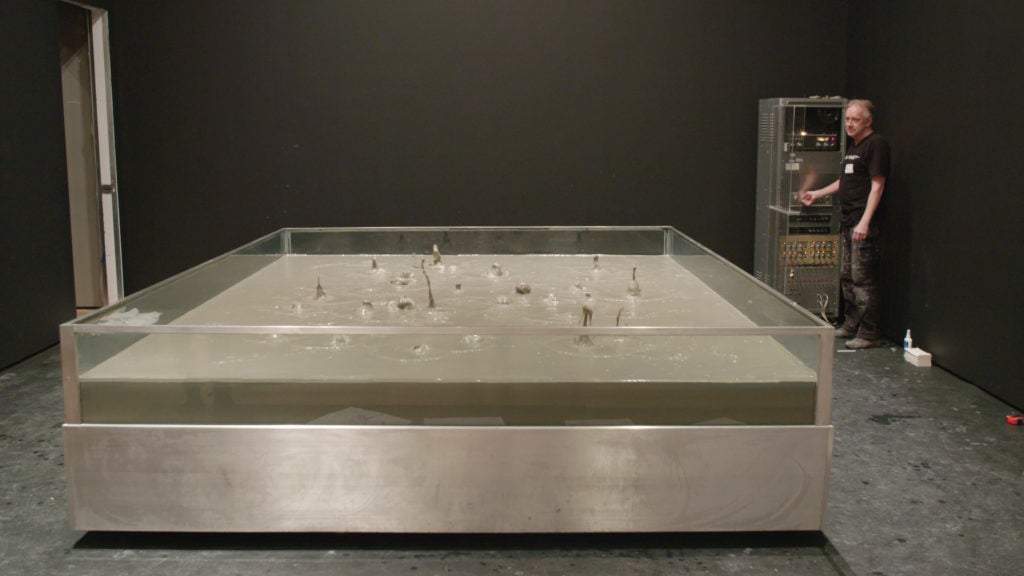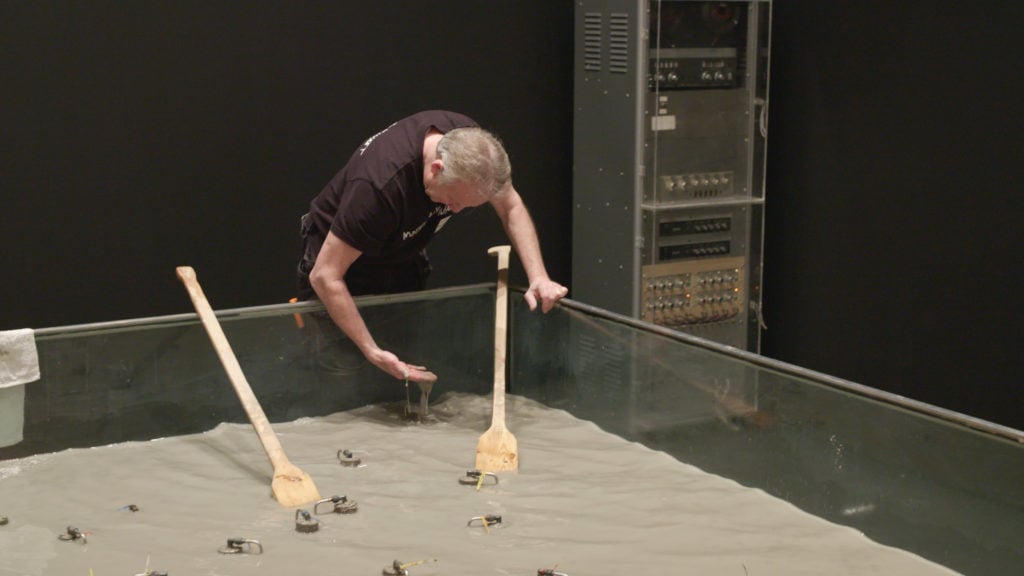Art World
Rauschenberg’s Musical Machine: The Story Behind the 8,000 Pounds of Mud Inside MoMA
There’s a lot of mud-slinging going on inside New York’s Museum of Modern Art this week.

There’s a lot of mud-slinging going on inside New York’s Museum of Modern Art this week.

Julia Halperin

The installation of the Museum of Modern Art’s Robert Rauschenberg retrospective got pretty messy this week. Ahead of the show’s opening on May 21, curators were tasked with mixing 8,000 pounds of mud inside a gallery on the museum’s fourth floor. The result: Mud Muse (1968–71), one of the most ambitious and technologically complex works the artist ever created. The installation—a vat the size of a swimming pool filled with gurgling, pungent mud—will be exhibited in the US for the first time in almost 20 years.
MoMA chronicled the zany installation process in a three-part video series. (You can view the first video, released today, at the end of this article.) It’s clear Mud Muse is not your standard pile of mud. The bottom of the vat contains a complex network of air pumps equipped with sound sensors. Based on the frequency of whatever music is playing, the pumps release varying amounts of compressed air, which in turn causes the mud to bubble up. Before long, the bubbles are gurgling in time to the music.

Robert Rauschenberg’s Mud Muse (1968-71), from the collection of the Moderna Museet in Stockholm. Photo via the Rauschenberg Foundation.
“This was cutting-edge technology at the time,” says Leah Dickerman, the painting and sculpture curator at MoMA who co-organized the show. The notion that sound could control motion “was an emerging sign of our own digital age.”
Rauschenberg created the work in collaboration with engineers from the aerospace and manufacturing corporation Teledyne as part of the Los Angeles County Museum of Art’s Art and Technology Program, which invited artists and scientists to work together to realize unconventional projects. It took him, and a team of five engineers, three years of trial and error to get Mud Muse right.
Assembly required
Some additional assembly was required when the work arrived at MoMA following its debut at Tate Modern in London, where the Rauschenberg retrospective closed last month. “When you receive it, you don’t have the clay—you just get the vat and the sound system,” Dickerman says.
To complete the work, a group of around five art handlers zipped themselves into Tyvek suits, grabbed industrial-size immersion blenders, and began combining bentonite—an absorbent, powered clay commonly used in the drilling of oil wells—with water to create the mud. (Rauschenberg may have been familiar with this process from his childhood spent around oil drilling in Texas.) “It looked like they were brewing some massive stew,” Dickerman says. “I thought they looked like oompa loompas.”
Luckily, Mud Muse also comes with its own personal caretaker, Gunnar Marklund, who oversaw the proceedings. The kindly Swedish exhibition technician and electrician for the Moderna Museet has been in charge of Mud Muse since 2004. (The work has been in the collection of the Stockholm museum since 1973.)

Still from “AT THE MUSEUM: Rauschenberg’s Mud Muse – Part 1,” courtesy The Museum of Modern Art, New York. Pictured: Gunnar Marklund, Technician at Moderna Museet with Robert Rauschenberg’s Mud Muse (1968–71). Bentonite mixed with water in aluminum-and-glass vat, with sound-activated compressed-air system and control console. Moderna Museet, Stockholm. Gift of the New York Collection. © 2017 Robert Rauschenberg Foundation
Marklund “has a sense of when the mud has achieved the right sense of liquidity—it’s a little more like slime than you might think,” Dickerman says. For his part, Marklund sees his custodianship of Mud Muse as a kind of sacred duty; he was tapped for the job after the previous caretaker suddenly died. (“They said, ‘Gunnar, you have to take care of the Mud Muse,’” he recalls.)
When it is on view, Mud Muse bubbles to the tune of a recording Rauschenberg made of the work itself bubbling to music played by his friends. But Marklund has a habit of testing the work to the more upbeat sounds of ABBA.
A feat of collaboration
Mud Muse is just one of the 250 works in MoMA’s retrospective, but it embodies many of the characteristics that defined Rauschenberg as an artist: relentless experimentation, an openness to unorthodox materials, a commitment to collaboration, and a passion for technological innovation.
“Many artists have antipathy for technology; you’re seeing it replace human subjectivity, the mark of the artist’s hand,” Dickerman notes. “But Rauschenberg embraced technology fully as a part of contemporary life, and you see that in his work. You realize how radical an act that was then: Not only is art strokes of paint on canvas, but it could be a technological construction as well.”
You can watch Marklund at work below in the first of a three-video series about the process of assembling Mud Muse. MoMA will release the second video on May 15 and the third on May 17.
“Robert Rauschenberg: Among Friends” is on view at the Museum of Modern Art, New York, May 21–September 17.